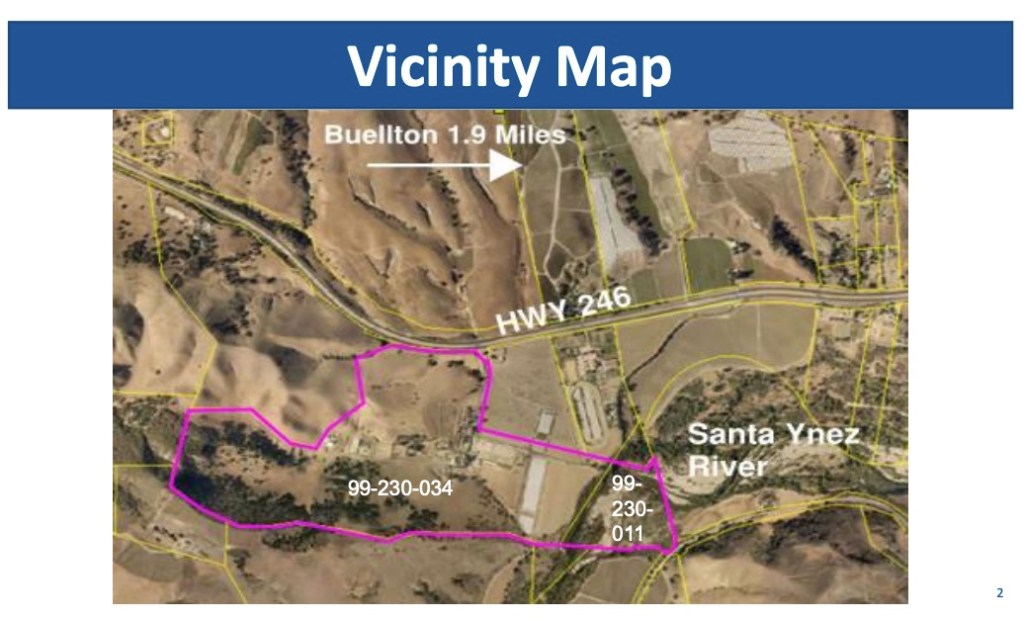The battle over growing cannabis in Santa Barbara County this time pit a coalition of residents and vintners against Castlerock Family Farms LLC in the Santa Ynez Valley. The Santa Barbara Coalition for Responsible Cannabis appealed the Planning Commission’s approval of the project to the Board of Supervisors, but it was denied 4-1 on October 6, with Supervisor Peter Adam voting against.
The grow itself is planned on a portion of the 600-acre Williams Ranch that has been leased to farmers for several decades. The acreage is roughly two miles west of Buellton at 2200 West Highway 246, next to a bend in the Santa Ynez River at its southernmost reaches and within shouting distance of the Sta. Rita Hills viticultural area. The closest tasting rooms are the Pence winery a half mile to the north of the site and the Peake Ranch winery a mile and a half to the south.
Get the top stories in your inbox by signing up for our daily newsletter, Indy Today.
What Supervisor Adam described as the assault of skunk smell — “A really important and intense smell, something normal people would not be able to ignore” — was the main issue, as it has been consistently for residents near marijuana grows. Described as most intense from flowering to harvest, the smell reaching into tasting rooms at nearby wineries would harm wine sales and the county’s tax dollars that came from them, not to mention the county’s reputation as a producer of premium wines, the appeal papers argued. Tasting rooms account for one-third of a winery’s direct sales, and ambiance, including smell, is an element for their success. More than half of the county’s taxable wine sales come from 13 percent of tasting rooms, and most of those are located at rural wineries, said attorney Courtney Taylor.
On the way to visit Castlerock’s proposed location, Adam had passed downwind of the Busy Bee cannabis operation, itself the object of a similar appeal in March. Busy Bee won the right to plant 22 acres in cannabis indoors and outdoors. The proximity of Busy Bee to Castlerock is part of a foreseeable problem of a concentration of cannabis in areas of the valley, said Supervisor Joan Hartmann, who represents the Santa Ynez Valley.
She described the weekend as over 100 degrees, smoky, and suffused with the cloying smell of cannabis. Hartmann said she was “shocked” to hear that Castlerock planned four harvests per year. Most farm growth cycles contemplated two harvests, with the exception being three, she said. Castlerock’s agent, Troy White, assured Hartmann that the number four was a “mere scrivener’s error” and that the correct number of harvests was three, as he had told Hartmann earlier.
Castlerock is seeking a land-use permit (LUP), which lacks the requirement to determine if a project is a detriment to the neighborhood that a conditional-use permit (CUP) would have. Planning Director Lisa Plowman explained the county would have a mechanism to look at concentration in the CUP process if a cannabis operation covered 51 percent or more of its parcel. Hartmann quickly did some addition and noted that even if the 100 acres in planning for cannabis near Castlerock were affected by the 51 percent rule, that did not solve the concentration of grows. The Sta. Rita Hills area alone was slated to hold 800 acres of cannabis. Hartmann bristled, “To claim we have one, then lo and behold, we have no tools, that’s disingenuous.”
Similarly, the board learned that odor control was so far unenforceable. Tracking down the source of the smells in Carpinteria had been unsuccessful, County Counsel Mike Ghizzoni said. No one was able to tell with accuracy what parcel the smell was coming from. “Ideally, there’d be one grow in an area,” he said, “but odor is hard to measure.”
The planning staff took a break in the middle of the appeal hearing to work out the “scrivener’s error” and get Castlerock’s approval. When they came back, Castlerock had agreed to limit harvests to three, to last two weeks, or no more than a month. Castlerock did not agree to mitigate odors.
Hartmann asked planning staff to report back on what the 51 percent rule meant for proposed projects. And despite the frustrations, she made the motion to approve the project. Among the qualities of the project Hartmann noted were that the grow consumed less than a quarter of its parcel, sat in a bowl of land, and was set well back from Highway 246. The project used the high value crop as the board had intended, she said, which was to cushion the landowner through the ups and downs of the agricultural economy.
Every day, the staff of the Santa Barbara Independent works hard to sort out truth from rumor and keep you informed of what’s happening across the entire Santa Barbara community. Now there’s a way to directly enable these efforts. Support the Independent by making a direct contribution or with a subscription to Indy+.

